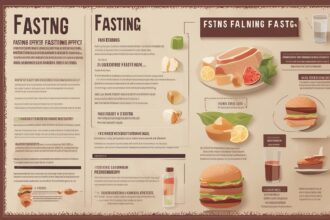Extended fasting—going without food for 24 hours or more—has surged in popularity for its potential health benefits, from weight loss to improved mental clarity. But let’s be real: the biggest hurdle for most of us isn’t the science or the willpower; it’s the gnawing, relentless hunger that creeps in like an uninvited guest. Managing hunger during extended fasts can feel like wrestling a bear sometimes. How do you tame that beast without breaking your fast or losing your mind? I’ve been there, and after multiple long fasts (including a 72-hour stretch that tested every ounce of my resolve), I’ve learned a few tricks to keep hunger at bay. In this post, I’ll share practical, battle-tested strategies, sprinkle in some expert insights, and help you navigate those growling stomach moments with confidence.
Why Hunger Feels So Intense During Extended Fasts
Before we dive into managing hunger, it’s worth understanding why it hits so hard during extended fasts. When you stop eating, your body shifts gears. For the first 12-18 hours, it burns through stored glycogen in your liver and muscles for energy. Once that’s depleted, it starts tapping into fat reserves—a process called ketosis. Sounds great, right? But here’s the catch: during this transition, your hunger hormone, ghrelin, often spikes, screaming at your brain that it’s time to eat. Add to that a drop in blood sugar, and you’ve got a recipe for feeling like you could devour an entire pizza in one sitting.
I remember my first 48-hour fast—around hour 30, I was fantasizing about burgers while pacing my kitchen. It’s not just physical; hunger plays mind games, too. Your brain, conditioned by years of regular meals, panics when the usual food cues aren’t met. Understanding this helped me realize it’s not weakness; it’s biology. And knowing that, you can outsmart it.
Stay Hydrated: Your First Line of Defense
If there’s one golden rule for managing hunger during extended fasts, it’s this: drink water like it’s your job. Dehydration can mimic hunger, tricking your brain into thinking you need food when all you need is a tall glass of H2O. Aim for at least 2-3 liters daily during a fast, more if you’re active or in a hot climate. I’ve found that sipping water throughout the day keeps my stomach from feeling completely empty, almost like a little placeholder for food.
But don’t stop at plain water. Add a pinch of Himalayan salt or a splash of lemon to replenish electrolytes lost during fasting—sodium and potassium imbalances can make hunger worse. Black coffee or unsweetened herbal teas are also fair game. A cup of green tea around mid-afternoon has been my saving grace on many fasts; it dulls the hunger pangs just enough to keep me sane. Just steer clear of artificial sweeteners—some studies suggest they might trigger insulin responses or cravings, derailing your efforts.
Distraction Is Your Secret Weapon
Ever notice how hunger seems loudest when you’re sitting idle? That’s no coincidence. Boredom amplifies every stomach growl into a full-blown symphony. One of the best ways I’ve found to manage hunger during extended fasts is to keep busy. Dive into a project, go for a walk, or binge a podcast series—anything to shift your focus. During my longest fast, I tackled a home organization project I’d been putting off for months. By the time I looked up, six hours had passed, and the hunger had faded into background noise.
Light physical activity can work wonders, too. A gentle yoga session or a slow stroll can boost endorphins and distract you from food thoughts. Just don’t overdo it—intense exercise on an empty stomach can spike hunger or leave you dizzy. The goal is to occupy your mind, not punish your body. What’s your go-to distraction? Finding something that clicks for you can make all the difference.
Electrolytes and Supplements: A Hunger Hack
Let’s talk about electrolytes again because they’re a game-changer. When you fast, especially beyond 24 hours, your body excretes more sodium, magnesium, and potassium through urine. Low levels of these can intensify feelings of hunger or fatigue, making you more likely to cave. I learned this the hard way during a 36-hour fast when I felt shaky and ravenous despite drinking plenty of water. A quick fix? A small dose of electrolyte powder (sugar-free, of course) mixed into my water. Within an hour, the hunger dialed down a notch.
Some fasters also swear by a tiny bit of apple cider vinegar diluted in water to curb appetite. The science is shaky, but anecdotally, it’s worked for me on occasion—maybe it’s the placebo effect, but I’ll take it. Always check with a healthcare provider before adding supplements, especially if you’re on meds or have health conditions. For more on balancing nutrients during fasting, check out our post on Fasting and Nutrition Tips.
Mindset Matters: Reframe Your Hunger
Here’s a mental trick that’s helped me immensely: don’t fight hunger—embrace it. Sounds counterintuitive, I know, but hear me out. Instead of viewing hunger as a tormentor, think of it as a sign your body is doing its job, burning fat, and resetting. During my 72-hour fast, I started telling myself, “This pang means I’m in ketosis, and that’s progress.” It didn’t erase the discomfort, but it took the edge off psychologically.
Mindfulness practices like meditation can also help. A quick 10-minute guided session focusing on breathwork has pulled me out of many a hunger spiral. If meditation isn’t your thing, journaling your fasting goals can reinforce why you’re doing this. Remind yourself of the bigger picture—whether it’s better health, mental clarity, or spiritual growth. Curious about the mental benefits of fasting? Our guide on Fasting for Mental Health dives deeper.
Break the Fast Smartly to Avoid Overeating
Even if you master managing hunger during extended fasts, the real test often comes when you break it. If you’ve ever scarfed down a huge meal post-fast (guilty as charged), you know it can undo some of your hard work with bloating or discomfort. The key is to ease back into eating with small, nutrient-dense foods. Start with bone broth, a handful of nuts, or steamed veggies—something easy on the stomach.
After my first long fast, I made the mistake of diving into a heavy pasta dish. Big regret. My stomach cramped for hours. Now, I plan my first meal ahead, keeping it light and hydrating. This not only prevents overeating but also helps sustain the appetite control you’ve built during the fast. Want ideas for post-fast meals? Peek at our Post-Fasting Meal Plans for inspiration.
Know When to Listen to Your Body
While pushing through hunger is part of extended fasting, there’s a fine line between discomfort and danger. If hunger turns into dizziness, extreme fatigue, or nausea, it’s time to stop. Fasting isn’t a one-size-fits-all deal, and your body’s signals matter. I’ve had to cut a fast short once at 40 hours because I felt genuinely unwell—not just hungry, but shaky and disoriented. Breaking it with a small meal was the right call, no shame in it.
Experts like Dr. Jason Fung, a leading voice on intermittent fasting, emphasize that fasting should never compromise your health. If you’re new to extended fasts or have underlying conditions like diabetes, consult a doctor first. Safety isn’t just a suggestion; it’s a must. Hunger management is about endurance, not recklessness.
Final Thoughts on Taming the Hunger Beast
Managing hunger during extended fasts isn’t about ignoring your body or white-knuckling through misery. It’s about strategy—hydrating like a pro, distracting your mind, balancing electrolytes, and reframing discomfort as a sign of progress. Imagine you’re on day two of a fast, stomach growling, but you’ve got your water bottle in hand, a podcast queued up, and a mindset that says, “I’ve got this.” That’s the sweet spot.
Every fast is a learning curve. What works for me might need tweaking for you, and that’s okay. Experiment with these tips, track how your body responds, and build a toolkit that fits your lifestyle. With practice, hunger becomes less of a monster and more of a manageable nuisance. So, next time you embark on an extended fast, don’t dread the hunger—outsmart it. You’ve got the tools now; how will you use them?
References
- National Center for Biotechnology Information: Effects of Fasting on Hunger Hormones
- Harvard Health: Intermittent Fasting and Appetite Regulation
- Dr. Jason Fung: Understanding Hunger During Fasting
- Mayo Clinic: Safety Tips for Fasting Diets
This content is for informational purposes only and not a substitute for professional advice.






